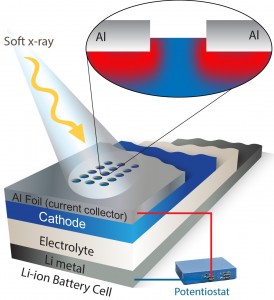 Over the past several years, scientists have developed several ways to study the changes in a working electrode. These include techniques based on hard X-rays, electron microscopy, neutron scattering, and nuclear magnetic resonance imaging.
Over the past several years, scientists have developed several ways to study the changes in a working electrode. These include techniques based on hard X-rays, electron microscopy, neutron scattering, and nuclear magnetic resonance imaging.
But most of these methods track structural changes. They don’t track electron and ion dynamics directly, which is very important in the push to understand and optimize battery performance.
Soft X-ray spectroscopy, one of the most sensitive probes of electronic states, has been mainly limited to ex situ experiments for battery research, but now cientists from Berkeley’s Advanced Light Source achieve in situ and operando soft X-ray absorption spectroscopy of lithium-ion battery cathodes.
The discoveries described in a recent article in Nature Communications demonstrate the feasibility and power of in situ soft X-ray spectroscopy for studying integrated and dynamic effects in batteries.
“The shallow probe depth of soft X-rays becomes an advantage in this case because it provides the chance to obtain position-sensitive information on the electron and ion migration,” says Wanli Yang, a scientist at Berkeley Lab’s Advanced Light Source who developed the technique with Gao Liu of Berkeley Lab’s Environmental Energy Technologies Division.
Read the interview here http://newscenter.lbl.gov/feature-stories/2013/12/04/better-batteries/
